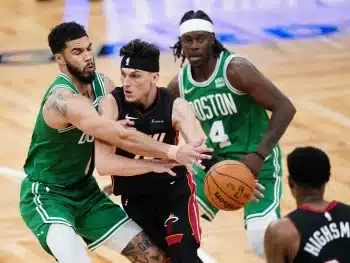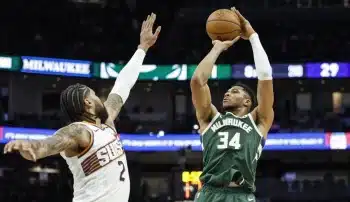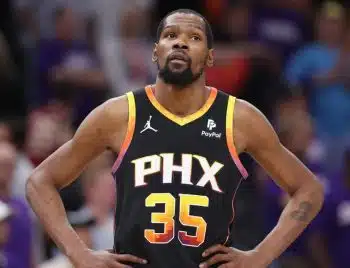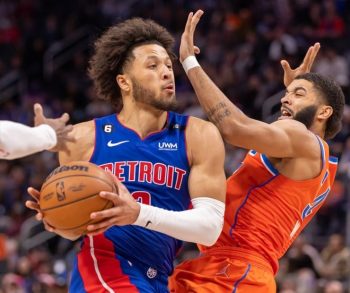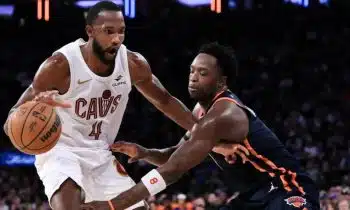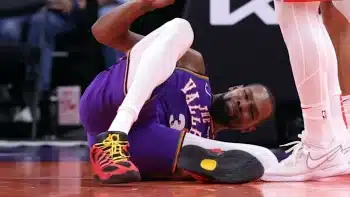NBA
Sabonis, Turner Providing More Answers Than Questions
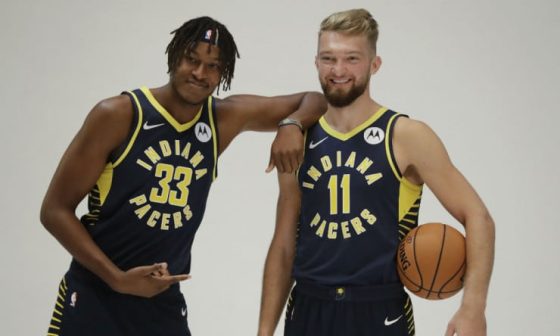
Nate McMillan almost made it seem like the Indiana Pacers’ hand was forced.
With Domantas Sabonis eligible for an extension until late October or entering restricted free agency next summer, it was crucial for the Pacers to prove that he’s a part of their long-term plans. Coming off a breakout season that cemented him as one of the most productive young bigs in basketball, too, Sabonis made it clear he wanted a more significant role – and Indiana, positional redundancies and stylistic complications be damned, had no choice but to give it to him.
“Last season, you’re trying to find ways for him get more minutes,” McMillan told reporters on Pacers Media Day last week. “He feels he’s a starter. He feels he’s a starter, he wants to become a starter, he expressed that to us. We had to make room for him to do that. We felt that he was part of the future of this organization, and we had a starting center in Myles [Turner].
“We had to make room for him.”
There’s an important distinction between the Pacers honoring Sabonis’ desires at the expense of team success and doing so with that overarching factor in mind. In 2019, it’s taboo for a team to start a pair of traditional big men. The league is smaller than ever before and faster than it’s been in 30 years. Committing major minutes to an old-school frontcourt – even one including an established superstar – is contrary to not just where the game is right now, but all of the signs point to the trend continuing.
Indiana understands that reality, of course. If there’s anything to be taken from McMillan’s forthright explanation behind Sabonis’ promotion, it’s that both he and the organization at large understand the potential pitfalls of such a development. Sabonis and Turner no doubt do, too. But just because the Pacers are aware of the risk they’re taking by entering the 2019-20 season with a frontcourt better suited for decades earlier hardly means the possible rewards don’t outweigh it.
That much was clear on Friday in Mumbai at the inaugural NBA India Games, where Indiana beat the Sacramento Kings 132-131 in an overtime thriller that functioned much more like a game that mattered than both teams’ preseason opener.
Sabonis and Turner shared the floor for just less than 16 minutes in their first ever start as teammates, with the Pacers outscoring the Kings by 13 points. Indiana shot a scorching 18-of-32 from the field with Sabonis and Turner playing together and absolutely dominated both the offensive and defensive glass, which McMillan suggested at Media Day was key to their sustained viability as a tandem.
The Pacers won’t always put up a 144.1 offensive rating during stretches featuring their new starting frontcourt. Much of that gaudy number, for instance, is owed to the red-shot shooting of T.J. Warren, who poured in 30 points and went 5-of-6 from deep in his Indiana debut. Still, the eye test from Friday’s game certainly lends credence to the hope that offense may not hold the Sabonis-Turner partnership back.
Turner has received a lot of flak for his natural inclination to set up a step or two inside the arc as both a ball-screen partner and off-ball shooter. He took 3.3 mid-range jumpers per game last season, per NBA.com, hitting them at a solid 41.2 percent clip. But Turner has worked tirelessly to realize his pre-draft potential as a three-point shooter, and is comfortable enough in that regard by now that he should always launch triples rather than long twos.
On Friday, with Sabonis mostly serving as Indiana’s designated roll man, Turner made a concerted effort to retreat behind the arc if he found himself inside it when ball handlers turned the corner.
Turner tried just one three-pointer against Sacramento, a look from above the break he let fly in transition with no hesitation whatsoever. It would be supremely disappointing if he didn’t attempt at least three triples per game this season; four would be a number with which Indiana should be happy.
Don’t confuse Turner’s inability to get up threes on Friday as any harbinger of hesitance to come. The Kings were simply so overwhelmed by their opponent’s size and execution that there weren’t many opportunities for Turner to shoot threes within the flow of the offense and random ball movement.
The space provided by Turner stationing himself on the perimeter, like a stretch four, made stopping the Pacers’ real power forward next to impossible.
Sabonis has a keen sense of timing as a roller, frequently finding cracks within the defense to make himself available for a pass, and is one of the most accomplished dribble hand-off partners in the NBA. He went 9-of-11 from the restricted area all by himself on Friday, on multiple occasions out-muscling Marvin Bagley III for thunderous dunks and routinely using his patience and footwork in a crowd to find room to finish.
But it’s not just his effectiveness as an interior scorer that separates Sabonis from other offensively-minded bigs with limited shooting range. Sabonis is a dangerous, clever passer from all over the floor, a trait that seems to be rubbing off on Turner entering his fourth season in the league.
Most concerns about playing two traditional big men revolve around shooting. Small-ball has grown so ubiquitous across the league, though, that spreading the floor with one-dimensional shooters is no longer enough. On the game’s best offenses, those guys can make smart plays with the ball, too.
Sabonis was blessed with that ability from the womb, and Turner has already made the type of playmaking strides some thought he never would. The latter found T.J. McConnell on Friday with a slick bounce pass after letting him turn the corner on a would-be dribble hand-off, a staple of Sabonis and other impactful high-post passers.
But it’s the big-to-big passing that was most impressive in Indiana’s exhibition debut. There will inevitably be times when Sabonis and Turner both find themselves in the paint when the other has the ball, and it’s imperative they’re able to make quick passing reads in small spaces to get out of that bind – a difficult task they at times made look easy.
While most of the hand-wringing in Indiana about matchups comes on the other side of the ball, Sabonis and Turner were able to use their collective size to an advantage against Sacramento. With Luke Walton matching up positionally, slotting his centers on Turner, the Pacers consistently exploited Sabonis’ strength edge over Bagley and Nemanja Bjelica. Even Turner, showing off some canny deception, found him for a pair of baskets on early-clock post-ups.
The Kings are an especially favorable matchup for the Pacers. They don’t have a big man physical enough to bang bodies with Sabonis defensively, and ranked 26th in defensive rebounding percentage last season before adding Dewayne Dedmon and Richaun Holmes, average rebounders at best. There will be nights when Sabonis doesn’t have a favorable on-one-one matchup, and there will be nights when the Pacers can’t glean easy extra points from wrecking the offensive glass.
There were nevertheless enough signs in Sabonis and Turner’s first game as Indiana’s starting frontcourt to come away very encouraged. It shouldn’t have been all that surprising the double-big look was successful; lineups featuring Sabonis and Turner posted a plus-3.4 net rating last season, per NBA.com, mostly on the strength of defense. But with Victor Oladipo playing beside them, that number bumped up to all the way up to a dominant plus-13.0, as the Pacers scored nearly five more points per 100 possessions and managed to get even stingier defensively.
The sample size is small, and it’s foolish to expect Oladipo – whenever he returns – to immediately be the player he was before rupturing his quad last January. More likely is that he struggles to reach that level until after the All-Star break, or even next season.
Kevin Pritchard did well over the offseason to bring in ball-handlers and scorers who help compensate for Oladipo’s absence – and maybe more importantly, both now and going forward, delay the need for the Sabonis-Turner combination to be a clear strength offensively.
Warren, a natural bucket-getter, proved on Friday that his career-best campaign from deep last season was no fluke, and Malcolm Brogdon thrived playing full-time point guard, especially when running high pick-and-roll with Sabonis. Jeremy Lamb, starting in the backcourt in Oladipo’s stead, is a more dynamic scorer than any guard this team took to the playoffs last spring.
Sabonis and Turner are still a long way from proving their partnership is viable offensively. The Pacers were elite on defense with them on the floor together a year ago, but it’s telling that against Sacramento McMillan spent the last few minutes of the fourth quarter with Turner manning the middle, then had Sabonis take his place for the duration of overtime.
Harrison Barnes, playing power forward for the Kings down the stretch on Friday, isn’t exactly Giannis Antetokounmpo or Khris Middleton, any three of the Boston Celtics’ talented wings, nor Pascal Siakam, the players Sabonis will be tasked with checking when Indiana meets other likely playoff teams in the East. The Philadelphia 76ers’ similar size and far superior talent is another thing entirely.
Questions on both sides of the ball abound for the Pacers. As the regular season quickly approaches, though, there’s ample reason to believe the long-made decision to start a throwback frontcourt was the right one – and not just because they “had to make room” for Sabonis.
